Below Nathan Palmer, faculty in the Department of Sociology and Anthropology at Georgia Southern University, shares some great ideas on how to teach students about making heroes, the social construction of reality, and rituals.
Students are filing into a large lecture hall. An empty stage in front of them with a simple black text on white background powerpoint slide reads, “What if we treated sociologists as celebrities or sports heroes?” At 9:00 am exactly the lights dim and a hyped up song begins to play. Students are looking around the room for answers when over the speakers they hear, “Ladies and gentlemen, may I have your attention please as we announce tonight’s starting lineup for your very own Georgia Southern Eagles! Starting at teacher hailing from the University of Nebraska, it’s NAAATHAAAAN PAAALMEEER!!!” The music reaches a crescendo as I storm in from the back of the auditorium, slapping high fives with students as I make my way to the stage. Once on the stage I pour baby powder in my hands and throw it in the air mimicking LeBron James’s pre-game ritual. Then I point both my fingers to one side of the room just like the fastest man in the world Usain Bolt does.
Heroes, Celebrities, and Constructing Reality
The music stops. When the students stop laughing hysterically I start a discussion about how we “make sports heroes.” We talk about the lights, music, the announcer’s tone of voice, the crowd participation and all the other rituals we do across the country at sporting events. This is a great way to discuss the social construction of reality in a way that students really connect with. I also bring in Durkheim’s insights about rituals and community building. Nowhere in the United States is there a more naked concerted effort to clearly define an “us” and a “them” as there is at sporting events.Typically my students want to take the conversation beyond sports and look at pop-culture celebrity making. This is an easy transition given that the way we make pop-culture celebrities is very similar to sports hero making. Students talk about movie trailers with quick cuts and a dramatic voice over. They talk about TMZ, Extra!, and other celebrity news magazines that prop up the most mundane behaviors as being amazing and trend setting.
Inevitably, one student will say, “I hate celebrities and sports heroes. The real heroes of the world are Pat Tillman and the men and women who serve our country.” This is a excellent opportunity to talk about the rhetorical frames we use to describe soldiers. I will ask the class, “How do we talk about soldiers and the military in the United States when we want to honor them?” The class is quick to use words like sacrifice, bravery, courage, and honor. This demonstrates to the class that even when talk about people who do more than score a touchdown or star in a movie, we still use symbols and rhetorical devices to socially construct a heroic reality for them.
Making Your Intro Music
Creating your audio introduction is fairly easy. I buy a high energy top 40 song off of iTunes each semester so that my students will immediately recognize the song. iTunes is great because you can buy a “clean” or censored version of the song and it will only cost you $1.29. Most recently I used the song “Winner” by Jamie Foxx. After you pick a song you can use free programs like Audacity on a PC or GarageBand on a Mac to record your “announcer intro” and then mix the track with the song you’ve chosen.Teaching symbolic interaction is typically something we all do during the first weeks of a introduction to sociology course. This activity is especially good because it affords us an opportunity to break student expectations early. As I am sure is apparent by now, this activity takes a fair amount of courage on your part. However, by putting yourself out there, so to speak, you can shatter student preconceptions about professors and college classes. You can also rest assured that your students will leave class and tell all their friends about what they learned in sociology today.
Teaching as Theater
The reality is, if you are teaching 100+ students in a large lecture hall you are doing performance theater like it or not. When students walk into a theater sized classroom and when you stand on a stage with a microphone, it should surprise no one that students expect to be entertained. As sociologists we have a unique opportunity to play with student expectations and violate norms in a way that both makes for good pedagogy and good theater.

